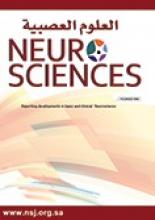Abstract
OBJECTIVE: To study the effect of analgesia caused by a local anesthetic agent (Lidocaine) in morphine dependent and independent rats.
METHODS: We carried out this experimental study in the Neuroscience Research Center of Kerman Medical University, Iran in 2003. We evaluated 2 groups of morphine dependent and independent rats. Morphine dependency was induced orally, and formalin was used as a noxious stimulus. The orofacial formalin test in rats is a valid and reliable model of nociception. The formalin test induces 2 distinct periods of nociception reaction, the first phase occurs in the first 3 minutes and the second phase 15-45 minutes later. The behavioral response of the animals to the noxious stimulus (formalin) was measured by the time the animal spent rubbing the injected area. All the injections were carried out subcutaneously into the upper lip of the animal, at the same site if possible. The effect of morphine dependency on local analgesia was assessed by injection of 50 uL lidocaine prior to 50 uL diluted formalin (2.5% in saline) in one group, and after formalin in the other group.
RESULTS: Subcutaneous injection of lidocaine prior to morphine completely abolished the first phase of formalin nociceptive response in both morphine dependent and independent rats. Injection of lidocaine after formalin did not affect the first phase in both groups, but abolished the first part of the second phase in both groups.
CONCLUSION: Considering different mechanisms of morphine and lidocaine in the body, the results verified that the analgesia induced by lidocaine in both morphine dependent and independent groups was the same, and we do not need higher doses of lidocaine to suppress formalin induced pain in the morphine dependent group.
- Copyright: © Neurosciences
Neurosciences is an Open Access journal and articles published are distributed under the terms of the Creative Commons Attribution-NonCommercial License (CC BY-NC). Readers may copy, distribute, and display the work for non-commercial purposes with the proper citation of the original work.






